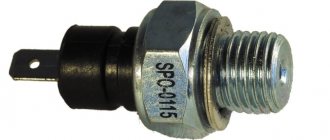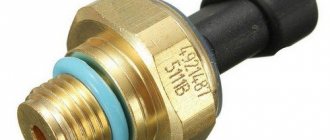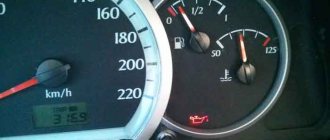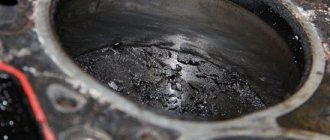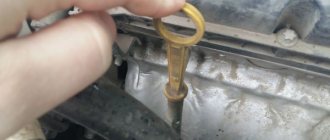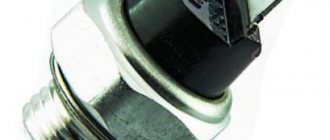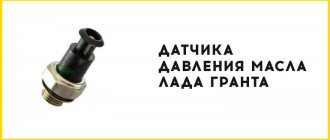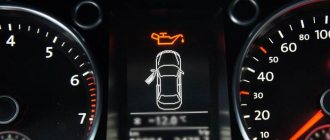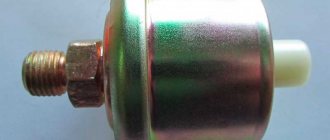The question is how to check oil pressure sensor (hereinafter referred to as DDM) is of interest to drivers who have encountered problems with the operation of the engine oil system, in particular when the oil light is on. You can check this unit using an electronic or dial multimeter, a test light or a working pressure gauge. The verification procedure is simple, and even a novice car enthusiast can do it. The following are detailed verification algorithms indicating the subtleties and nuances.
Operating principle of the oil pressure sensor
Before figuring out how to check the oil pressure sensor, it is necessary to briefly discuss the theory, in particular, how the oil pressure sensor works. This will give a complete understanding of the process. First of all, it is necessary to point out that there are two types of oil pressure sensors - mechanical (installed on old cars, in particular Soviet models) and electronic (more modern, widely used in the automotive industry).
Mechanical Sensor Design
Mechanical DDM device
Inside the mechanical sensor there is a membrane that changes its shape depending on the pressure applied to it. Accordingly, the larger it is, the more the membrane bends. By bending, it acts on the rod present in the design, which is responsible for compressing the liquid in a special sealed tube. At the other end of this tube there is a rod on which this liquid pressed, and the second rod moved the needle of a device - a differential pressure gauge, or simply a pressure gauge. The pressure increases - the arrow goes up, the pressure drops - the arrow goes down.
There is also another, more common device, a mechanical oil pressure sensor. It is similar, but with the addition of a variable resistor - rheostat. So, a resistor is placed on the membrane present in its design, which changes its resistance depending on the actual value of the applied forces. Accordingly, the greater the membrane deformation, the more the sensor resistance changes. If there is no membrane deformation, the resistance value will be zero. This change is recorded by the electronic engine control unit (ECU), to which the corresponding signal is sent. Its software is designed in such a way that it controls whether the signal from the DDM is within a certain interval corresponding to the normal operating oil pressure in the engine oil system. As a rule, dial pressure gauges are attached to mechanical sensors, the scale of which shows the absolute value of the oil. Although in fact these devices are voltmeters, the needle of which changes its position in accordance with the resistance value coming to the device from the DDM.
Electronic sensor design
Electrical DDM device. 1 — rod, 2 — signal lamp, 3 — contacts, 4 — membrane
The design of the electronic oil pressure sensor (by the way, is installed on VAZ-2114 cars and its analogues, new Lada models) implies that when the membrane is flat (not under pressure), the supply circuit of the signal lamp on the instrument panel is normally closed, so it turns on under appropriate conditions. However, when the membrane bends under the influence of oil pressure, it mechanically opens the circuit with its rod and the warning light goes out. This, in fact, happens when the engine starts, which can be judged by the fact that the oiler light is in the active state (lit) when the ignition is turned on, as well as for the first 1...2 seconds.
Thus, the essence of checking a modern DDM is to measure the resistance of the sensor winding with a multimeter switched to the mode of measuring electrical resistance (ohmmeter). However, it can also be checked using other methods.
Features of work
Then, membrane sensors began to be used on machines to determine the operating parameters of the lubrication system. They come in two types:
Mechanical ones are outdated and not used. The measuring device consisted of two sensors - membrane and measuring. They were connected by a tube filled with oil. The essence of the work is very simple - increasing pressure in the system leads to bending of the membrane installed inside the sensor. The membrane moves, pushes the rod, which squeezes out the oil in the tube. The resulting pressure caused the needle on the measuring sensor to move, and the driver determined the pressure in the system using a set scale. This is how diagnostic analog pressure gauges work now.
Sensor diagnostics
As mentioned above, there are two types of pressure sensors - mechanical and electronic. Accordingly, the procedures for checking the emergency oil pressure sensor in both cases will differ, albeit slightly (only the design features of these sensors apply). First of all, you need to make sure that the oil pressure sensor is faulty. To do this, you will need to perform additional diagnostics of the oil system - check the oil level in it, the condition of the filter, pump, and so on. If suspicions fall specifically on the serviceability of the oil pressure sensor, then first of all it is necessary to remove it from its seat with the engine turned off (as a rule, it is located in the area of the oil filter).
Where is the oil pressure sensor
Find out where the oil pressure sensor is located on different car models, since it depends on the design of the engine, and on some cars there are as many as two Read more
Typically, keys of various diameters are used for this, for example, 24, 27 or others (depending on the specific car model). After this, do not forget to plug its seat with a rag so that when the engine is running, oil does not leak out of it, and various debris or small parts (bolts, nuts, etc.) do not get into the oil system!
It is also advisable to check the pressure in the car's oil system. To do this, you need to screw a pressure gauge into the seat from which the DDM was unscrewed, with which you can take a control measurement of the oil pressure at various engine speeds. Please note that in this case it is necessary to ensure maximum tightness so that the pressure gauge readings are extremely accurate. You definitely need to look at the pressure when the engine is running at idle, as well as at medium and high speeds.
The corresponding pressure will be different for different machines, so you will find the exact information in the manual or technical documentation for a specific machine. If the pressure value is normal, but the information does not reach the ECU, then the sensor is most likely to blame, so it needs to be checked.
How to find out if the engine oil sensor is faulty using an auto scanner
On all modern cars, problems with the sensor can be indicated not only by the oil lamp, but also by the “check engine” indicator. Scan Tool Pro Black Edition helps to find out the reason , which should be connected to the ECU connector and connected to the engine control module (ECM) from a smartphone or tablet via Bluetooth or Wi-Fi through an available application.
Oil pressure and check engine indicator
Engine Oil Sensor Error
Depending on the nature of the problem, engine oil pressure sensor error codes may be stored: P0520, P0521, P0522, P0523 and P0524. In real time, you can connect to the control unit and see the presence of errors, as well as the reading of the oil pressure sensor (voltage to the sensor and oil temperature). This will allow us to more accurately determine the cause of the malfunction.
Thanks to the 32-bit chip, Scan Tool Pro will not only allow you to read and reset engine errors, but also measure operation in other car systems (gearboxes, transmissions, ABS, ESP, etc.) at certain time intervals and save the data in mind.
How to choose a new sensor?
In some situations, they try to select the model of the emergency oil pressure indicator based on the make and model of the car, but this approach does not provide a 100% guarantee of compatibility. Therefore, it is much more profitable to select by VIN code, this will help avoid problems with matching.
Rice. 8. Selection of emergency oil pressure sensor by code
Otherwise, in order to purchase a product of proper quality, you should follow several rules:
- Avoid temptingly low prices - if the cost is significantly lower than the market average, it is most likely a fake.
- The image on the label must be clear, the letters are clearly visible, and not blurred.
- In accordance with clause 3.2. GOST 22520-85 the body of the new part must have no visible mechanical damage - scratches, chips, cracks, etc.
- The kit includes both the sensor itself and the o-ring for it. In the case of a fake, quite often the product is not equipped with a gasket in order to save money.
Checking the electrical oil pressure sensor
Checking the sensor with a multimeter
Electronic oil pressure sensors, used both on foreign and domestic cars, in particular on VAZ-2114 cars and other modern Ladas, are easy to check. Their design is similar to that of a rheostat, but they simply open the circuit at a certain pressure. Accordingly, its verification is even simpler. To do this you need:
- Set the multimeter to the “continuity” (break) mode of the electrical circuit.
- Ensure a tight connection between the air pump and the inlet (sensitive) hole where air is supplied. Here, similarly, it is necessary to ensure high-quality sealing, since the result of the experiment directly depends on this.
- Place one multimeter probe on the central output contact of the sensor, and the second on its body, “ground”.
- At the same time, use a pump to apply air pressure of about 1...1.5 atmospheres to the sensor. There is no need to blow hard so as not to damage the membrane. If the sensor is working properly, the electrical circuit will open almost immediately, under the mechanical action of the rod, which is in rigid connection with the bending sensitive membrane of the oil pressure sensor.
As is clear from the operating diagram of the sensor, if the circuit is open (detected with a multimeter), then the sensor is working. Otherwise, no. In rare cases, instead of the sensor, the problem why the oil light is on must be looked for in faulty (broken or damaged insulation) wiring.
You can also check the performance of the oil pressure sensor using another method. So, you need to remove the power wire from the sensor and short it to ground. If the sensor is working properly, the warning light on the dashboard should not light up. Otherwise the sensor is faulty.
Checking two sensors
On some modern machines, two pressure sensors of the same type (“new”) are installed. The first is designed for an absolute pressure value in the range of about 0.15...0.45 atmospheres, and is designed to open the warning lamp after starting the engine. Its verification is similar and follows the procedure described above. That is, the connection is the same. Its circuit should open when pressure is pumped into it in the specified range.
The second sensor is designed to monitor oil pressure while the engine is running. It is similar in type to the first, but its difference is to control the upper limit of the oil (in order to prevent it from increasing to a critical value). The upper value may vary and differs for specific car models. However, in most cases it is around 1.8 atmospheres. When this pressure level is reached or higher, the contact circuit should close and the engine oil pressure warning light should be activated on the instrument panel.
Checking the pressure sensor using a light bulb
To check the electric (new) oil pressure sensor, instead of a multimeter, you can use a light bulb designed to operate under 12 V DC voltage, as well as a power supply (battery) and a compressor (preferably with a pressure gauge). The verification algorithm is as follows:
Connection diagram
- Two wires must be connected to the contacts of the light bulb.
- Connect one end of the wire going to the light bulb to the output contact of the pressure sensor.
- Connect the ground from the power supply (or minus from the battery) to the housing (ground) of the sensor.
- Connect the plus from the power supply or battery to the other wire on the light bulb.
- If the sensor is working properly, then after turning on the power supply (or simply when contact is made from the battery), the light should light up. Otherwise, the sensor can immediately be considered faulty.
- Next, to check, you need to apply a pressure of about 0.5 atmospheres to the sensitive element of the sensor using a compressor or pump. The pressure value can be different, and it depends on what pressure the sensor is designed for. Usually it is around the already mentioned 0.5 atmosphere.
- When the pressure increases to the specified value (critical for the sensor), the light should go out, since this will open the control electrical circuit in the sensor body. If this does not happen, then the sensor can also be considered unusable.
Instead of a compressor, you can easily get by with a regular car or even bicycle pump, which will easily produce the required half-atmosphere air pressure.
Symptoms of malfunction
The main driver symptom of P0523 is the MIL (Malfunction Indicator Light). It is also called Check engine or simply “check light”.
They can also appear as:
- The “Check engine” warning light on the control panel will light up (the code will be stored in memory as a malfunction).
- Oil pressure warning light illuminated.
- When the engine is running, various mechanical noises may occur, which change as the rotation speed changes.
- Engine cylinders may misfire, especially if the problem is related to low oil pressure.
The P0523 oil pressure code is considered very serious, so it is recommended to fix this problem as soon as possible. For example, if the oil pressure is too low, it can cause the crankshaft and connecting rod bearings to seize.
Mechanical sensor check
Checking an old mechanical sensor (for example, installed on some VAZ “classic” models and old foreign cars, for example, “Volvo 240”), with the help of which it is possible to directly find out what pressure is currently available in the car’s oil system, can be done even without multimeter, but using additional devices (air pump and electric car pressure gauge). The sensor similarly must be removed from the car, since it will not be possible to test it directly on the engine.
Checking the sensor with a pressure gauge
The test is a little more complicated than with electronic ones, but this lies, first of all, in some difficulty in assembling the electrical circuit. You need to act according to the following algorithm:
How to check a mechanical sensor, connection diagram
- On the sensor you need to find a contact that produces a signal for the oil pressure warning light on the car's dashboard, as well as another contact from which a signal is sent to indicate oil pressure. For further measurements, you will simply need to take the “ground” from the sensor housing (under normal conditions, all sensors simply take “mass” from the engine housing).
- Similarly, on an electronic pressure gauge, you need to figure out where to connect the plus and minus of its power supply, as well as the signal directly from the sensor (that is, there are three contacts).
- Connect the electrical circuit and tightly connect the air hose connecting the pump and the sensor sensing element.
- Next, you need to use a pump to apply 1…2 atmospheres to the sensitive element of the sensor. If it is working properly, then the dial pressure gauge will clearly show the incoming pressure. If this does not happen, it means the oil pressure sensor is faulty.
As a rule, oil pressure sensors cannot be repaired, so if they are found to be faulty, the unit must be replaced. Fortunately, these elements are inexpensive and are available everywhere in almost any auto store.
Please note that when installing the sensor on its seat after checking, it is recommended to lubricate it with heat-resistant sealant.
Why the meter may fail
Malfunctions of the oil pressure sensor are due to the following reasons:
- valves or pump diaphragm are damaged;
- deposits have formed on the walls of the pipe, which are caused by the accumulation of waste material;
- the motorist has not changed the oil for a long time;
- the filter is clogged with waste material;
- mechanical damage to the rod (it is because of this that there may be insufficient oil pressure);
- short circuit;
- Due to long-term operation, the main elements of the oil line have worn out.
One head it's good, but two better
On numerous forums on the Internet, you can often find stories from experienced car enthusiasts that, along with an electronic oil pressure sensor, they installed a mechanical one in parallel with it. In particular, this is expressed in the fact that in the event of a drop in oil pressure, not only the corresponding warning lamp on the instrument panel will light up, but the absolute value of the pressure will also be visible on a pressure gauge installed somewhere in the area of the instrument panel.
This is done for the reason that sometimes, for example, after a major overhaul on the engine or when using low-quality (or outdated) engine oil that has become clumped, the sensor’s sensitive element does not work properly, respectively. Accordingly, when the pressure drops, the warning lamp does not light up, which is a critical fact, since the engine in such conditions runs “dry”, that is, without proper lubrication. This significantly reduces its resource and can completely damage the motor in the shortest possible time.
Thus, car enthusiasts install a so-called tee at the connection point of the pressure sensor, at one output end of which a traditional electronic sensor is connected, and at the other - a mechanical one. The hose with wires is mounted in the engine compartment in accordance with the engine design. The main thing is that it does not interfere with other elements of the motor, and is not subject to mechanical or significant thermal effects. A pressure gauge is installed at its end, for example, from a VAZ classic, UAZ or another similar device. In fact, its model is not important, the main thing is that it is convenient to navigate the scale, that is, it must have detailed graduations.
Conclusion
The pressure sensor is a fairly reliable unit and rarely fails. Therefore, if problems arise with the oil system indication system, it is necessary to check other parameters - oil pressure, the presence of leaks, the condition of the oil itself, its level and the oil filter, and only after that check the condition of the oil pressure sensor. In general, checking the serviceability of this unit is not very difficult, and even novice car enthusiasts can do it, literally using a car compressor and a multimeter. If the sensor fails, it is hardly possible to repair it, so it is better to buy a new DDM at a car dealership, since it is inexpensive.
Diagnosis and problem solving
Make sure the oil level is at the correct level, that it is not diluted with fuel or coolant, or has a thick, tarry consistency. If necessary, add or change the oil before proceeding with further diagnostics.
Perform a thorough visual inspection of the wiring to look for damaged, burnt, disconnected, shorted or corroded wires and connectors. If necessary, repair, clear the P0523 code and rescan the system to see if the code returns.
Checking wiring with a multimeter
Once no visible damage is found, check resistance, ground, and reference voltage. Compare all readings obtained with the data specified in the manual. Replace wiring as necessary to ensure all readings are within manufacturer specifications.
Be sure to disconnect the oil pressure switch from the PCM while checking resistance and continuity to prevent damage to the controller. You should also check the oil pressure switch as it is part of the control circuit.
Checking oil pressure
It is necessary to ensure that the oil pressure is within the range specified by the manufacturer, this can be done by attaching a pressure gauge to the engine. Using a scanner is not recommended because the scanner uses the same information as the PCM.
The PCM and scan tool may indicate an oil pressure condition that is based on incorrect data.
The pressure gauge may take a few seconds to register a reading, but should stabilize after about ten seconds. Record the reading and compare it with the value stated in the manual.
Allow the engine to warm up while watching the pressure gauge. As it warms up, there may be a slight drop in pressure indicated by the pressure gauge. But the oil pressure should not drop below the minimum specified value when the engine is at operating temperature.
Oil pressure readings that are not within acceptable lower limits indicate excessive wear or other mechanical problems within the engine. In this case, simply replacing the oil pressure switch will not solve the problem of error code P0523.
Related DTC Discussions
- My first post p0327 p0332 p0523 p1626
P0327 - Knock Sensor Circuit Low Voltage P0332 - Knock Sensor 2 Circuit Input Low (Bank 2) P0523 - Engine Oil Pressure Sensor/Switch Circuit Voltage High P1626 - Theft Deterrent System Enable Signal Not Received Hello, this is my first post in Saudi Arabia. I am receiving these codes. I have an ac... - 2002 Jeep Grand Cherokee p0300 p0305 p0308 p0523
Hi Jeff Compton (or others), I hope you are still using this board and answering questions. I recently purchased a 2002 Jeep Grand Cherokee overland edition. I got several codes. p0300 p0305 p0308 and p0523. I replaced the oil pressure transfer unit with a mopar part.. I did it soon aft... - 2001 Jeep Grand 4.7 codes P0202, P0352, P0443, P1492, P1499, P0523 and P0443
I received my 2001 Jeep Grand 4.7 misfire, rough idle, loss of power, number 2 cylinder not working, changed PDA, gas filter, fuel pump, cam position sensor, injectors, spark plugs but no change, I got these codes, P0202, P0352, P0443, P1492, P1499, P0523 and P0443, anyone to help... - P0523 2009 Honda Accord 3.5L
Can I drive a 2009L 3.5 Accord with code P0523?… - 2008 Cadillac SRX code P0523
2008 CADILLAC SRX won't start code po523... - 2007 Cadillac SRX4 AWD codes P0017 and P0523
Replaced all 4 camshaft position sensors and crankshaft position sensor. Now I'm getting codes P0017 and P0523. Any ideas about what? Why?… - 2002 Jeep Grand Cherokee 4.0 code P0523
2002 Jeep Grand Cherokee 4.0. A month ago my Jeep would stall at idle all the time, the code said temp sensor, I replaced it and now after a few weeks it started stalling at idle again, now it shows p0523 oul pressure sensor but it can cause stall at idle go all the time, if not why...
